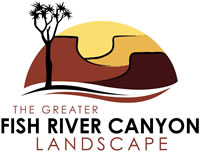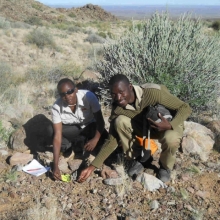Research
Research is ongoing on many aspects of the Landscape. Examples include
- population sizes and distributions of fauna through the annual game counts
- vegetation assessments through monitoring and surveys
- single-species reintroductions and monitoring, such as the Mountain Zebra project
- resource management, such as water basin management
- archaeological and heritage surveys
- part of the landscape falls within the SKEP project (Succulent Karoo Ecosystem Project) - a long term, bi-national conservation and development initiative between Namibia and South Africa which includes many research activities
You can find information on many of these research activities below.
Relevant literature
-
2003 Game count data
Gondwana Canyon Park Game Count 2003.
Spreadsheet containing the results of the 2003 game count in the Gondwana Canyon Park.» Download -
2004 Game count poster
Gondwana Canyon Park Game Count 2004.
Poster summarising the results of the 2004 game count in the Gondwana Canyon Park.» Download -
2005 Game count poster
Gondwana Canyon Park Game Count 2005
Poster summarising the results of the 2005 game count in the Gondwana Canyon Park.» Download -
2006 Game count presentation
Gondwana Canyon Park Game Count 2006.
Presentation summarising the results of the 2006 game count in the Gondwana Canyon Park.» Download -
2007 Game count presentation
Gondwana Canyon Park Game Count 2007.
Presentation summarising the results of the 2007 game count in the Gondwana Canyon Park.» Download -
2008 Game count poster
Gondwana Canyon Park Game Count 2008
Poster summarising the results of the 2008 game count in the Gondwana Canyon Park.» Download -
2009 Game count poster
Gondwana Canyon Park Game Count 2009
Poster summarising the results of the 2009 game count in the Gondwana Canyon Park.» Download -
2010 Game count poster
Gondwana Canyon Park Game Count 2010
Poster summarising the results of the 2010 game count in the Gondwana Canyon Park.» Download -
2011 Game count poster
Gondwana Canyon Park Game Count 2011
Poster summarising the results of the 2011 game count in the Gondwana Canyon Park.» Download -
2012 Game count poster
Gondwana Canyon Park Game Count 2012
Poster summarising the results of the 2012 game count in the Gondwana Canyon Park.» Download -
2013 Game count poster
Gondwana Canyon Park Game Count 2013
Poster summarising the results of the 2013 game count in the Gondwana Canyon Park.» Download -
A Brief Heritage Survey of the /Ai-/Ais Richtersveld Transfrontier Park (ARTP)
A Brief Heritage Survey of the /Ai-/Ais Richtersveld Transfrontier Park (ARTP), July 2013
The /Ai-/Ais Richtersveld Transfrontier Park, hereafter referred to as ARTP, has significant geological and palaeontological, natural, archaeological and architectural heritage. The area also has a substantial and complex historical and cultural heritage. Fully mobilised, this heritage would add substantial value to tourism in the ARTP and assist local people with the development and protection of their culture. The tourism potential of the ARTP as a whole could be expanded by fully unlocking the tourism potential of all heritage categories in the ARTP. This is the result of an initial survey of heritage resources in the ARTP. The survey focus on archaeological, paleontological, natural and geological heritage as well as places and buildings of historical significance» Download -
Biodiversity zonation of the Greater Fish River Canyon Landscape
Burke, A. 2013. Biodiversity zonation of the Greater Fish River Canyon Landscape. Report of field survey in the Nama Karoo area
As part of a biodiversity zonation for the Greater Fish River Canyon Landscape the summer fieldtrip April-May 2013 targeted six areas, which were selected on the basis of data gaps, representation of the landscape and rainfall patterns. The Orange River mountains proved the most exciting from a plant research perspective, as new distribution records may have been found here.» Download -
Biological characterisation of the Orange-Fish River Basin, Namibia
Irish, J. 2009. Biological characterisation of the Orange-Fish River Basin, Namibia. Report produced for the Ephemeral River Basins in Southern Africa (ERB) Project, Desert Research Foundation of Namibia (DRFN: Windhoek)
Ephemeral River Basins (ERB) in Southern Africa is a project that promotes the sustainable, equitable and improved utilisation of water and other natural resources in ephemeral river basins in southern Africa through the process of integrated resource management (IWRM). Although IWRM is accepted – internationally and regionally – as the approach promoting sustainable management of water resources and the river basin is considered the ideal unit over which to apply it, the basin management approach has not been widely tested and implemented in ephemeral river basins in southern Africa.» Download -
Historic distribution of large mammals in the Greater Fish River Canyon Complex, southern Namibia, and recommendations for re-introductions
Brown, C.J. 2006. Historic distribution of large mammals in the Greater Fish River Canyon Complex, southern Namibia, and recommendations for re-introductions.
This report looks at the historic distribution of larger mammals in the Greater Fish River Canyon Complex of southern Namibia. Based on this information, as well as the present distribution of mammals and the present environmental conditions within and surrounding the Complex, it makes recommendations for the re-introduction and enhancement of large mammal populations.» Download -
Integrated Water Resources Management (IWRM) - Orange-Fish River Basin
Ministry of Agriculture, Water and Forestry. Integrated Water Resources Management (IWRM) - Orange-Fish River Basin
The Orange-Fish River Basin is located in southern Namibia across parts of the Hardap and Karas Regions. It can be divided into Orange and Fish sub-basins, occupying 15% of the Namibian land surface in total. It is home to an estimated 77 000 people, which represents 56% of the total population of the two regions» Download -
Monitoring the reintroduction of Burchell’s zebra in Gondwana Cañon Park
Gosling, M. 2013. Monitoring the reintroduction of Burchell’s zebra in Gondwana Cañon Park
As part of Gondwana Cañon Park’s commitment to enriching the large mammal community of southern Namibia, it reintroduced 26 Burchell’s zebra in July 2006. This report provides an update on the population in 2013.» Download -
Mountain Zebra Project
The purpose of the Mountain Zebra Project is to promote the study of mountain zebras for scientifically based population management and promote them as as a flagship species for wider ecosystem conservation in Namibia. The project is comparing the ecology and behaviour of the species across a variety of habitats and developing study techniques that are useful in sites with different conservation management objectives.» Download -
Mountain Zebra Project – 4th progress report
Gosling, M. 2012. Mountain Zebra Project – 4th progress report. Population ecology of Hartmann’s mountain zebra: comparisons between protected areas in southern Namibia.
This is the fourth progress report on a long-term study of the population ecology, social evolution and conservation of Hartmann’s mountain zebra. The aim of the study is to provide information to help support the conservation of this sub-species in Namibia.» Download -
The socio-economic agricultural baseline survey done in the communal areas of the Karas region
Louwrens, A. 2004. The socio-economic agricultural baseline survey done in the communal areas of the Karas region. Agricola, 14: 43-51
During 2000 a very comprehensive survey was carried out in the communal areas of the Karas Region (Tses, Berseba, Bethanie and Bondelswarts). This article portrays some of the results of that survey. Results are presented on the socio-economic status of households, focusing specifically on household description and house- hold income. The article also includes information on productive resources such as water, firewood, land and live- stock, as well as on project participation of members of the community and support provided to them by government organisations and NGOs.» Download




